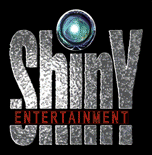Shiny Entertainment
 | |
| Private | |
| Industry | Video game industry |
| Fate | Merged |
| Successor | Double Helix Games |
| Founded | 1993 |
| Founder | David Perry |
| Defunct | 2007 |
| Headquarters | Laguna Beach, California, U.S. |
Key people | David Perry |
| Parent | Foundation 9 Entertainment |
| Website |
www |
Shiny Entertainment, Inc. was an American video game developer based in Laguna Beach, Southern California, and the creator of titles including Earthworm Jim, MDK and Enter the Matrix. The company was founded by David Perry in October 1993.[1] In 2007, Shiny Entertainment merged with The Collective to create Double Helix Games.
History
Formation
In 1991, video game developer David Perry was working for Probe Software in London on the movie license based video game The Terminator for the Mega Drive/Genesis. The game was to be published by Virgin Games in Irvine, California. After a proposal was made, Perry agreed to complete the work in the United States and moved over to join the Virgin Games USA development team. While in the states he developed McDonald's Global Gladiators and 7-Up's Cool Spot, did early development work on Disney's The Jungle Book and worked on Disney's Aladdin in a joint venture of Virgin Games USA with Sega of America which was commercial successful.
At this time Perry got a US green card, and formed the new company. To fund it, he signed a three-game distribution deal with Playmates Interactive Entertainment and Shiny Entertainment Inc. was formed in October 1993.
The company's first release was Earthworm Jim for the Sega Mega Drive/Genesis. It was commercially successful and won the Sega Game of the Year award. Several merchandising deals followed which resulted in an Earthworm Jim TV show, comic books, toy lines and other products. The game was later ported to more platforms and a sequel, titled Earthworm Jim 2, followed in 1995. The same year, the company was acquired by Interplay Entertainment, and half of the original eight-man team, including Perry's right-hand man Doug TenNapel, left to form the gaming company The Neverhood, Inc.[2] Sega and Nintendo had also made offers to acquire Shiny Entertainment but were turned down because, according to Perry, "we've always wanted to cover the whole gaming field."[3]
In 1997 former Shiny employees Nick Bruty (President) and Bob Stevenson (CEO) left to form the company Planet Moon Studios.
After the two Earthworm Jim games Shiny created MDK, a 3D action game and one of the precursors of the third person shooter genre, which would be released in 1997 for PC and ported to several other platforms in 1998. Interplay co-published MDK with Playmates Interactive Entertainment.
In 2000 Shiny Entertainment released two games from two different genres, the 3D action game Messiah and the 3D real-time strategy game Sacrifice. Neither became as successful as Shiny's previous releases. Messiah was perceived by professional reviewers as a rushed release with technical problems and flawed gameplay. Sacrifice was well received by critics but still did not become a commercial success.
Acquisition by Infogrames
In 2002 Shiny was acquired by Infogrames (which later changed its name to Atari) for $47 million along with its then current project Enter the Matrix.[4] Despite poor critical reception, Enter the Matrix became a commercial success. Shiny created another game based on the same license, The Matrix: Path of Neo, which was released in 2005. Again the critical reception was mediocre and it did not become as commercially successful as the previous game.
Perry launched a new Earthworm Jim game for Sony's PlayStation Portable as well as a new fighting Game called Age of Elements at E3 2006,[5] none of which were ever finished.
Atari announced their interest in selling off all their development studios,[6] and Perry resigned. On October 2, 2006, Foundation 9 Entertainment acquired Shiny Entertainment.[7] In October 2007, Foundation 9 merged Shiny Entertainment with The Collective to form Double Helix Games.[8][9]
Games developed
- Earthworm Jim (1994)
- Earthworm Jim 2 (1995)
- MDK (1997)
- Wild 9 (1998)
- R/C Stunt Copter (1999)
- Messiah (2000)
- Sacrifice (2000)
- Enter the Matrix (2003)
- The Matrix: Path of Neo (2005)
- The Golden Compass (2007)
References
- ↑ Keefer, John (March 31, 2006). "GameSpy Retro: Developer Origins". GameSpy. Archived from the original on April 27, 2012. Retrieved October 23, 2016.
- ↑ "Gaming Gossip". Electronic Gaming Monthly. Ziff Davis (74): 44. September 1995.
- ↑ "A Shiny Look for Interplay". GamePro. IDG (83): 116. August 1995.
- ↑ "Infogrames Completes Acquisition Of Shiny Entertainment". Infogrames Entertainment. May 2, 2002. Archived from the original on April 28, 2003. Retrieved November 5, 2016.
- ↑ Feldman, Curt (May 17, 2006). "Q&A: Dave Perry's shiny new gig". GameSpot. CBS Interactive. Archived from the original on December 22, 2006. Retrieved November 5, 2016.
- ↑ Brightman, James (February 17, 2006). "Atari to Sell Off Studios in Turnaround Attempt". GameDaily. AOL. Archived from the original on December 2, 2008. Retrieved November 2, 2009.
- ↑ Dobson, Jason (October 2, 2006). "Foundation 9 Acquires Shiny From Atari". Gamasutra. UBM plc. Retrieved November 5, 2016.
- ↑ Sinclair, Brendan (October 9, 2007). "Foundation 9 merges Shiny, Collective". GameSpot. CBS Interactive. Archived from the original on October 12, 2008. Retrieved November 5, 2016.
- ↑ Sinclair, Brendan (March 27, 2008). "Shiny, The Collective twisted into Double Helix". GameSpot. CBS Interactive. Archived from the original on May 11, 2008. Retrieved November 5, 2016.
External links
- Official website at the Wayback Machine (archived March 29, 2008)